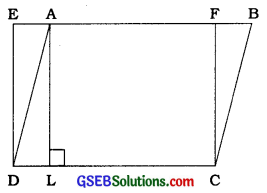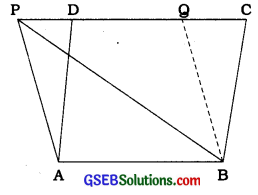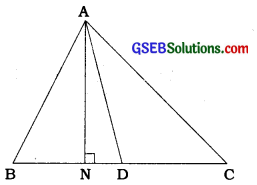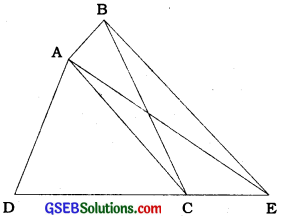This GSEB Class 9 Maths Notes Chapter 9 Quadrilaterals covers all the important topics and concepts as mentioned in the chapter.
Quadrilaterals Class 9 GSEB Notes
Planar region:
The part of the plane enclosed by a simple closed figure is called a planar region corresponding to that figure.
Area of a closed figure:
The magnitude or measure of the planar region cqrresponding to a closed figure is called its area. The magnitude or measure is always expressed with the help of a positive real number (in some units).
Areas of congruent figures:
- If two figures A and B are congruent, they must have equal areas. However, the -converse of this statement is not true. In other words, two figure having equal areas need not be congruent.
- Symbol for the area of a figure: Area of figure A is denoted as ar(A) symbolically.
Properties of area of figures:
- If A and B are two congruent figures, then ar (A) = ar (B).
- If a planar region formed by a figure T is made up of two non-overlapping planar regions formed by figures P and Q, then ar (T) = ar (P) + ar (Q).
Figures on the same base and between , the same parallels:
Two figures are said to be on the same base and between the same parallels, if they have a common base (side) and the vertices (or the vertex) opposite to the common base of each figure lie on a line parallel to the base.
Note: Out of two parallel lines, one line must contain the common base.
Parallelograms on the same base and between the same parallels:
- Theorem 9.1: Parallelograms on the same base (or equal bases) and between the same parallels are equal In area.
- The area of a parallelogram Is the product of Its base and the altitude corresponding to that base.
- Parallelograms on the same base (or equal bases) and having equal areas lie between the same parallels, one of which contains the same (or equal) base / s.
- If a parallelogram and a triangle are on the same base and between the same parallels, then the area of the triangle Is half the area of the parallelogram.
![]()
Example 1:
In the given figure, ABCD is a parallelogram and EFCD is a rectangle. Also, AL ⊥ DC.
Prove that:
(i) ar (ABCD) = ar (EFCD)
(ii) ar(ABCD) = DC × AL
Answer:

(i) As a rectangle Is also a parallelogram, ar (ABCD) = ar(EFCD) (Theorem 9.1)
(II) From above result, ar (ABCD) = ar (EFCD) = DC × FC
(Area of the rectangle = length × breadth) …… (1)
Since, AL ⊥ DC. AFCL is also a rectangle.
∴ AL = FC … …(2)
Hence, ar(ABCD) = DC × AL [From (1) and (2)]
Example 2:
If a triangle and a parallelogram are on the same base and between the same parallels, then prove that the area of the triangle is equal to half the area of the parallelogram.
Answer:
Let, ABP and parallelogram ABCD be on the same base AB and between the same parallels AB and PC (See the given figure).

Draw BQ ∥ AP to obtain another parallelogram ABQR Now, parallelograms ABQP and ABCD are on the same base AB and between the same parallels AB and PC.
∴ ar(ABQP) = ar(ABCD) (Theorem 9.1) ………… (1)
But, ∆PAB ≅ ∆BQP
(Diagonal PB divides parallelogram ABQP into two congruent triangles.)
∴ ar(PAB)=ar(BQP) …………(2)
∴ ar(PAB)= \(\frac{1}{2}\)ar(ABQP) [From (2)] ………….. (3)
Hence, ar (PAB) = \(\frac{1}{2}\)ar (ABCD) [From (1) and (3))
Triangles on the same base and between the same parallels :
Theorem 9.2:
Two triangles on the same base (or equal bases) and between the same parallels are equal in area.
Area of a triangle:
The area of a triangle is half the product of its base (or any side) and the corresponding altitude (or height).
Theorem 9.3:
Two triangles having the same base (or equal bases) and equal areas lie between the same parallels, one of which contains the base (or bases).
Property of a median of a triangle:
Any median of a triangle divides the triangle into two triangles of equal area.
Example 1:
Show that a median of a triangle divides it into two triangles of equal areas.
Answer:
Let, ABC be a triangle and let AD be one of its medians (see the given figure).

Since the formula for area involves altitude, let us draw AN ⊥ BC.
Now, ar (ABD) = \(\frac{1}{2}\) × base × altitude (of ∆ ABD)
= \(\frac{1}{2}\) × BD × AN
= \(\frac{1}{2}\) × CD × AN (∵ BD = CD)
= \(\frac{1}{2}\) × base × altitude (of ∆ACD) = ar (ACD)
![]()
Example 2:
In the given figure, ABCD is a quadrilateral and BE ∥ AC and also BE meets DC produced at E. Show that area of ∆ADE is equal to the area of the quadrilateral ABCD.

Answer:
∆BAC and ∆EAC are on the same base AC and between the same parallels AC and BE.
∴ ar (BAC) = ar (EAC) [Theorem 9.2]
∴ ar (BAC) + ar (ADC) = ar (EAC) + ar (ADC) (Adding same area on both sides)
∴ ar (ABCD) = ar (ADE)